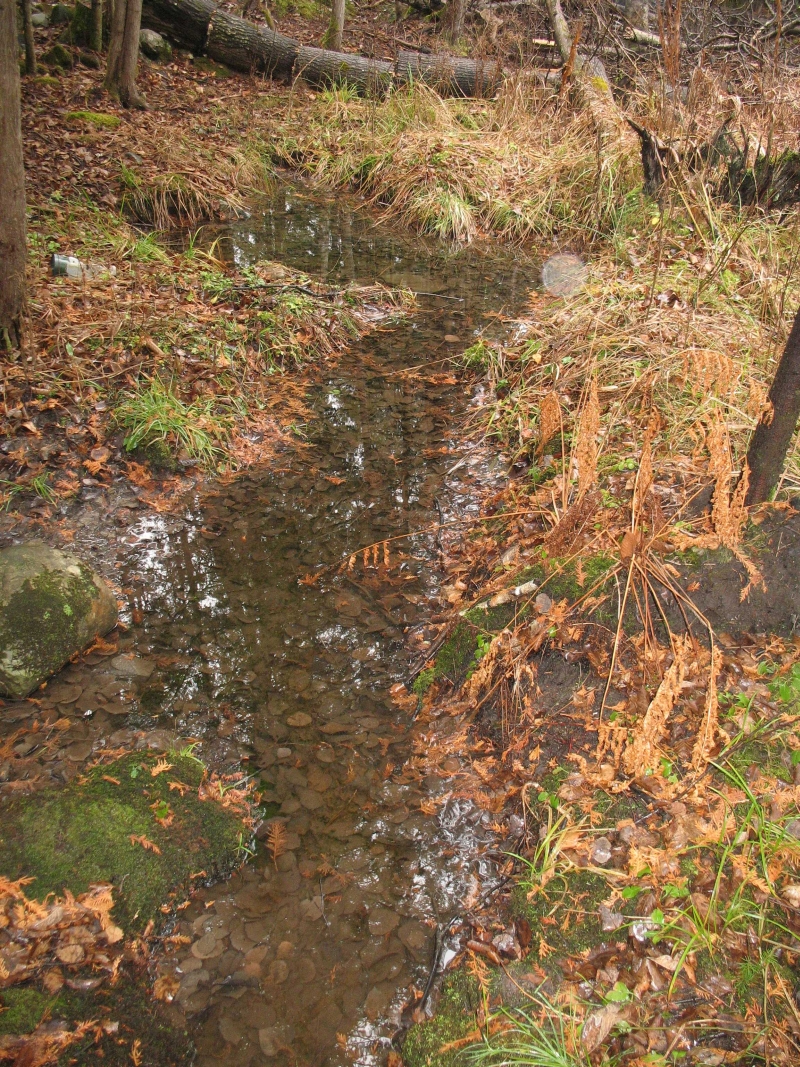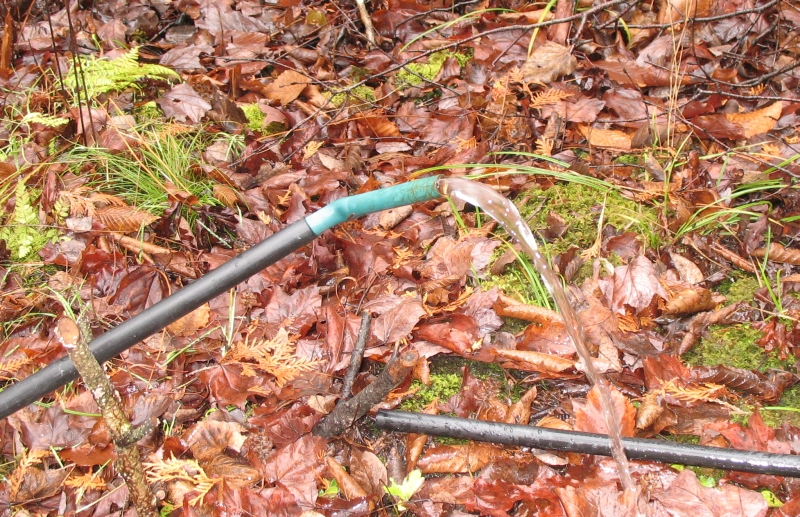Dealing withLow Pressure Wateror, “Why doesn’t this work like I thought it would?” Also see Click on photos to enlarge |
|
Often using a gravity feed system as a water supply involves dealing with low pressure water. Whether using the water for drip irrigation or to fill a cistern, you may encounter problems that seem baffling since low pressure water behaves quite differently than the high pressure water most of us are familiar with. This is due to the fact that the force of pressure pushing the water through the supply line is so low that it makes little problems much greater. This article describes our gravity feed system and some of my experiences and solutions over the past couple of decades dealing with our low pressure water system. Our low pressure system consists of three water sources: two seasonal springs a thousand feet back in the woods, and a series of 55-gallon barrels we have siphoned together to create a single reservoir.
I put the intake end of the hose through a slit in a half gallon milk jug. I also put several other slits in the jug along with several stones to keep it from floating. The jug’s purpose is to keep the end of the hose from laying directly on the silty bottom of the spring and sucking silt with the water. Nevertheless, a few times each year it does get clogged, so going to the other end of the hose and blowing hard expels any blockage. The output end of the hose is attached to a 400 foot long section of standard ½ inch black plastic pipe fitted with a female hose connection to connect it to the six foot hose going through the dam. The pipe then continues down hill to a low point, then up a slight incline, and then on a slight decline to greenhouse #1 where it empties into four 55 gallon drums siphoned together. In one of these drums is a 1/3 hp sump pump connected to garden hoses, which allows us to water the seedlings both inside and outside the greenhouse.
What’s happening as the water begins to flow is that air bubbles in the pipe—which were sucked into the pipe as the spring ran low and then were trapped wherever the downward slope of the pipe is interrupted by even an inch rise—are being forced along with the water flow until they find the end of the pipe. It is important to remove all of the air bubbles in the line or they will find homes in any slight rise and thereby restrict the flow of water. An easy way to determine if all of the air bubbles are out of the pipe is to hold your thumb over the end of the pipe for a second. If there are no bubbles, you’ll feel quite a bit of pressure immediately, then a lessening of pressure. Releasing you thumb will result in the water gradually beginning to flow again as it resumes its downhill journey. This happens because when the pipe is full of water, holding your thumb over the end stops the moving water and what you feel at first is the momentum of all that moving water. Once the water has come to a stop, all you feel is the weight of the motionless water. Removing your thumb allows the water to flow again, slowly at first as it gains momentum and returns to a normal flow rate. If there are air bubbles in the pipe, when you hold your thumb over the end you’ll feel a little pressure at first, then a gradually increasing pressure. When you stop the flow altogether the air in the bubbles begins to compress allowing the water to gradually come to a stop. As the air becomes more compressed, the pressure builds up. Releasing the water then results in the water spurting out very fast at first, then gradually slowing to a slightly less than normal rate. Eventually all the bubbles will be forced out with the flow and a full normal rate will be attained. Once the bubbles are out of the pipe, I reconnect the two sections. Now there is sufficient pressure built up by the 20 foot drop to this point to push any bubbles farther down the line out to the end of the pipe with no further assistance from me. During a dry August I may have to go through this procedure almost daily until—in the driest years—the spring does not recharge at all until the fall rains arrive. We have two sets of four or five 55 gallon drums, each set has the drums within it siphoned together so they act as one big storage tank. One set of these drums is in the greenhouse where pipe from the spring arrives. In the bottom of one of the barrels is a 1/3HP sump pump we use to pressurize the water for watering seedlings both inside and in front of the greenhouse. This allows us to use the warmer water that has been sitting in the barrels in the greenhouse overnight, instead of shocking our seedling with cold well water. |


